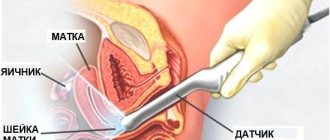You came for important information and now we’ll talk about Early pregnancy: what are the sensations in the abdomen and uterus, is it possible to determine this condition by touch. Maybe in your case it was different, but we’ll tell you how it usually happens. Attention, before prescribing diagnoses or medications/treatment for yourself, you should always consult with professional specialists in your field and not self-medicate. Of course, you can quickly find the answer to the simplest questions and diagnose yourself at home. Write your wishes in the comments, together we will improve and supplement the quality of the material provided.
Breast tenderness
A week or two after conception, women's hormonal levels change. For many women, breasts react to increased hormone levels with soreness and swelling. The nipples and the area around them darken, increase in diameter and become very sensitive. The mammary glands remain hypersensitive until the end of pregnancy, but discomfort is typical only in the early stages. Over time, the pain disappears.
The reaction of the mammary glands to pregnancy may be the opposite. For some women who previously complained of pain and tightness in the breasts before menstruation, these symptoms often disappear after conception.
Heaviness in the uterus and abdomen
Reliable signs of pregnancy.
«Is it possible to feel pregnancy early?
? - the answer to such a question is ambiguous, since only a professional can do this, and independent attempts are unlikely to bring results. The methods described below are effective only from the fourth to fifth month of pregnancy. For example, by feeling the uterus, it is possible to determine the parts of the unborn child. The easiest place to feel is the head (the round part), but you can also identify smaller parts like the legs and arms. You can feel the fetus moving with your hand. By using a stethoscope and a heart monitor, you can listen to the fetal heartbeat.
How to feel pregnancy
? The main part of determining pregnancy is examination of the vagina, as well as palpation of the uterus - a diagnostic test based on feeling certain parts. The normal size of the uterus is about 79 millimeters along the longitudinal axis. During pregnancy, these sizes increase. Until the end of the third month, the female uterus is located in the pelvic area, so it can only be examined by vaginal examination. Already from the fourth month, the uterus leaves this area because it does not fit in it (for this reason, the pregnant woman’s belly subsequently increases). Then it becomes much easier to palpate the uterus in the abdominal cavity.
Interesting on the web:
A healthy uterus in a non-pregnant girl is pear-shaped. During pregnancy, its shape changes. The uterus becomes spherical, then it becomes slightly asymmetrical, and then spherical again. During pregnancy, the uterus becomes softer. This happens because the number of muscle fibers and their size increases. This symptom is most pronounced in the cervix. In some cases, it manifests itself so strongly that the cervix, upon examination, appears to be separate from the body. A characteristic symptom is a change in uterine softness during pregnancy. At first it is soft, then it becomes denser.
Determining pregnancy without a test
A woman whose menstruation does not start on time is asked: is this pregnancy or a normal delay. The most reasonable way out of this situation is to go to a specialist and conduct a pregnancy test at home, but this is not always possible. Is there any other way to determine if you are pregnant?
These properties cannot be considered accurate, since similar symptoms may appear before menstruation. Additionally, some women who are nervous about becoming pregnant may experience nausea and other symptoms for psychological reasons.
In order to be able, if necessary, to determine the presence of pregnancy, get to know your menstrual cycle better and regularly keep a temperature chart. A situation in which high temperatures persist three days longer than in the normal corpus luteum phase will indicate that pregnancy has occurred. (This phase occurs after ovulation before the next menstruation, which is characterized by high temperatures - above 37 degrees).
More reliable symptoms include identifying parts of the fetus while feeling the uterus. It is easiest for the doctor to identify the dense round part of the head, as well as the small parts - the legs and arms. The fetal heartbeat is listened to with a stethoscope or heart monitor. These symptoms are one hundred percent capable of confirming pregnancy, but are quite late, since they can only be observed from the end of the fourth or beginning of the fifth month of pregnancy.
One of the important points in diagnosing pregnancy is palpation of the uterus and vaginal examination. The value along the longitudinal axis of the natural non-pregnant ma
Source
Hello! A friend’s period is 4-5 days late, she has a slight fever, and heaviness in her lower back. (I didn’t have a cold.) No nausea. I took 3 tests from different companies - negative results. I went to an appointment at an expensive center today. They didn't say "Yes" or "No". Is it really impossible to determine by palpation at this time? (Or is this pure business?) What do you think, is there a pregnancy or not?
They didn’t even tell me at 8 weeks, so I had to have an ultrasound. And I asked a gynecologist I know, she said that you can detect it with your hands already from the 5th week.
At this time, it is really impossible to determine accurately during examination. But why doesn't she do an ultrasound?! Ultrasound can be determined from 2-3 weeks. Besides, nothing should normally hurt. So far the picture looks more like dysfunction.
If you are a good doctor, then of course you can determine it at this time. But during pregnancy there is no fever. Most likely not a reassuring diagnosis!
Even with an ultrasound, pregnancy at this stage is difficult to determine, and even more so with palpation. If the test result is negative, it may not be pregnancy, but inflammation (especially if the temperature is elevated. But inflammation is not only of the pelvic organs (the gynecologist did not find anything), but inflammation, say, of the sciatic nerve or kidneys.
At this time, you won’t be able to determine anything for sure by palpation; you need to do an ultrasound or hormonal analysis. A delay in menstruation can be caused by several reasons, one of them is adnexitis. During pregnancy, fever and pain are definitely not the leading symptoms.
Of course not, even an ultrasound won’t show it at this stage. Your friend urgently needs to get tested for hCG hormone and rule out the possibility of ECTOPIC pregnancy!
There is only a fertilized egg in the uterus, so it is impossible to determine pregnancy by palpation at this stage. Many have already written about hCG and ultrasound!
if the tests are negative, then it’s unlikely
Source
Ectopic pregnancy.
This type of pregnancy is a rare pathological process in which the fetus develops outside the uterine cavity. In this case, the life of the woman in labor is at risk, since an ectopic pregnancy is characterized by tissue rupture.
Is it possible to feel an ectopic pregnancy?
? In the early months it can be extremely difficult to recognize such a pregnancy. The first sign is stabbing, sharp pain in the pelvic or abdominal area. Other symptoms may include low blood pressure, fainting, or dizziness. If the girl is quite thin, then you can lie on your back and try to feel a small bump in the ovarian area. This will indicate a possible ectopic pregnancy.
Determine pregnancy in the early stages (without a test or examination by a doctor)
Many women who have a full sex life have experienced anxiety about pregnancy at least once in their lives. Are there ways to determine the presence of pregnancy without a test before the delay? Let's try to find the answer to this question.
Surely, any gynecologist will tell you that it is basically impossible to determine the presence of pregnancy without a test and a visit to the doctor. Of course, there are certain symptoms that may indicate that a woman is pregnant. But it is worth remembering that only a competent examination, passing the necessary tests and a pregnancy test will ultimately help you determine whether pregnancy has actually occurred.
If you want to determine pregnancy without a test before the delay, then you should measure your basal temperature; if it is elevated (37 - 37.3 degrees), then the probability of pregnancy is quite high.
Nausea and vomiting may indicate pregnancy, however, not all women experience toxicosis in the early stages. Pain in the mammary glands may also indicate pregnancy. Sometimes the breasts in the early stages can hurt so much that any touch to them causes terrible pain, and the mammary glands can also increase in size. It is worth noting that pain in the mammary glands that does not go away may indicate an ectopic pregnancy. If only one breast hurts or there are lumps in it, then this is a good reason to contact a mammologist.
Pain in the uterus and ovaries, which may resemble menstrual pain, can also indicate pregnancy. As a rule, girls
Source
Video. Two lives are at stake. Ectopic pregnancy.
Self-diagnosis of pregnancy in the early stages causes certain difficulties. How to determine pregnancy by the cervix, if some girls do not know where it is and what it should look like in its normal state. Reviews and topics on forums speak about this. Even if, if conception is suspected, the woman herself does not intend to detect changes in the main reproductive organ, it is important to know about all her changes, which doctors use as a guide. The most accurate diagnosis will be from a gynecologist.
What is the complexity of the method?
The female body is designed in an amazing way - immediately after fertilization of the egg, the active growth of the fertilized egg begins and moves into the uterus.
Active hormonal and physiological changes immediately begin - the woman prepares for the successful bearing and birth of a child. But how can you independently determine pregnancy by looking at the cervix, even before going to the antenatal clinic? When examined by a gynecologist, you can even determine the gestational age by touch - the specialist uses palpation to determine the size of the organ with the embryo growing inside. You can give a more precise date if you keep a cycle chart where the days of ovulation are marked. At home, self-diagnosis will only be approximate. It is necessary to have at least a general idea of the size and shape of the cervix, its density and color before conception and after the fact, as in the figure.
Not all women, even those who have given birth, have a complete understanding of the internal genital organs and how they work. What is the role of each reproductive segment in PA, during fertilization and gestation? If you do not have this basic knowledge, it is difficult to understand how to determine pregnancy by the cervix.
Looking into yourself “there”, even with a mirror, is problematic, especially for overweight ladies. The only way to compare the cervix before and after pregnancy is to feel yourself in the vagina during hygiene procedures to compare the changes.
Attention: This type of diagnosis is very accurate, but it is also considered in terms of sensations and symptoms. Due to the difficulty of conducting a self-examination, it is rarely used even by those who know how to determine pregnancy themselves by looking at the uterus.
How to determine pregnancy without a test at home
How to determine pregnancy without a test and at home?
Any doctor will answer this question that there are no such methods. Of course, you can take a test to determine human chorionic gonadotropin in the blood, but this is still a clinical test, not a home diagnosis. What you will do at home and what you will get as a result are all probable, and perhaps far-fetched symptoms and signs. But be that as it may, women tend to believe in miracles, various signs and the experiences of their friends, therefore we will tell you how to determine pregnancy at home theoretically. In general, basal temperature is most often measured not with the hope of knowing your position early and without the help of doctors, but as an additional means of checking fertility and hormonal levels. In this case, it is necessary to start measurements from the first day of the menstrual cycle and enter all data into a simple graph consisting of an X and Y scale.
How to determine pregnancy by temperature? You need to start your tests no earlier than 1-2 days before the expected start of menstruation. The menstrual cycle is divided into 2 phases - before ovulation and after ovulation. And these phases are approximately the same in duration. The duration of the second phase is no more than 16-18 days. The second phase, if ovulation has occurred, is characterized by an increased basal temperature (slightly above 37 degrees). Closer to menstruation, it begins to decrease; if a decrease is not observed within two to three weeks, pregnancy is possible and quite likely.
Basal temperature, contrary to popular belief, is measured not only in the rectum, but also in the mouth, or in the vagina, but not under the armpit. You just need to hold a mercury thermometer in your mouth for 5 minutes, when measuring in the vagina or rectum
Source
Where is the cervix located?
The uterus is an internal organ and is therefore not visible.
The lower part of the cervix extends into the vagina; this is the visible part, which is used to make a visual diagnosis of the organ. It is tightly rooted in the vagina, so all sensations are transmitted from the walls of one organ to another (during PA and touching). You can detect pregnancy by palpation by the uterus, and visually by the cervix. The internal cavity of the uterus constantly produces mucus, including spotting during menstruation. A plug is formed in its neck, clogging the internal organ to protect against infections and moisture from the external environment.
Attention: Do not think that the cervix is a secondary organ; the level of protection of the fetus and its retention during pregnancy depends on its condition. If it has lost firmness and elasticity, the doctor, upon examination, can determine an upcoming miscarriage and take measures to preserve the pregnancy.
The specialist also knows how to determine pregnancy with uterine fibroids (internal neoplasm from pathological tissue proliferation).
During a visual examination, the doctor can evaluate only the cervical part, but this is enough to assess the health of the entire reproductive organ. The cervix has the simplest structure - a rounded muscular body, slightly protruding in the upper part of the vagina. It differs in tissue structure and color from the vaginal walls. This pinkish lump is covered with mucus and has a small hole in the center - the cervical canal. It is closed in the normal state, but expands slightly during menstruation.
The passage to the uterus is filled with a mucus plug. The size of the cervix is small - approximately 2.5 cm in circumference to 4 cm in length. It's amazing how this miniature light pink "tunnel" opens and widens during childbirth to allow the baby's head to emerge into the passage!
During ovulation, the mucus plug liquefies so that the most active sperm can overcome this barrier. The cervix rises slightly and becomes softer, making the vagina more free for penetration of the male organ.
How to detect pregnancy by touch
Every gynecologist knows how to determine pregnancy by the uterus, even in the early stages - the lower part of this organ is informative. It shifts, the color, size and density of tissues change, they say that the cervix can be soft and “oaky”. These changes are considered the most significant signs of pregnancy, along with the absence of menstruation on time. In addition, traces remain on the cervix:
- transferred operations;
- abortions and miscarriages;
- safe birth;
- internal uterine pathologies.
You can understand a lot by the state of the vaginal part, for example, if the neck is flat - the woman has not given birth, if the neck is cone-shaped - there has been childbirth.
But it is not only possible to determine pregnancy by touch by touching the cervix. Really understand the phase of the cycle (preovulation, ovulation, premenstrual). A specialist can easily diagnose the accomplished fact of fertilization, even the approximate gestational age. In nulliparous women, this pharynx is small and rounded; after childbirth, it closes like a slit. After a caesarean section, the cervix looks more like the cervix of a nulliparous woman, although the cervix becomes slightly larger in size.
You need to know about this before determining pregnancy by touch in the uterus:
- In women, before pregnancy, the cervix is hard, approximately like the wings of the nose; after conception, it is softer, approximately like lips.
- Before pregnancy, the cervix has a velvety pink color, after which it turns blue (from active blood circulation and the proliferation of the vascular network in order to actively supply the fetus with nutrients).
- Under the influence of progesterone (hormone), the cervix lowers - a consequence of completed fertilization.
Let's return to the question “how to determine pregnancy by touch?” Considering the above - only in terms of relative softness and lowering of the neck. Visual changes are difficult to notice without a special inspection tool.
Determine pregnancy by palpation
Many women are interested in the question of whether it is possible to determine pregnancy even before a missed period. Usually a specialist can do this by visually examining a woman's vagina. But in this article you can read about other ways to determine pregnancy at an early stage.
To establish a reliable diagnosis, a woman must visit a gynecologist. An examination and taking the necessary tests will allow you to determine the presence of pregnancy before your period is missed. At home, a woman can determine pregnancy by some signs of her condition.
In the early stages, determining pregnancy is simply necessary. A woman who wants to give birth to a healthy baby must take pregnancy detection seriously before her period is missed. This will allow you to gain significant time in order to eliminate possible negative factors.
A visual examination allows the doctor to see significant changes in the woman’s genitals already at the initial stage of pregnancy. If a woman is expecting a child, then the mucous membrane of her vagina takes on a bluish color. It becomes more swollen than before. The cervix has a special shape and is slightly closed. With the help of palpation, an increase in the density of the uterus and its slight elevation are determined.
If pregnancy is detected in the early stages, a general blood test is performed. If the result is positive, it shows an increase in the number of ESR and leukocytes. Moreover, such changes begin almost from the first day of pregnancy.
Determination of pregnancy by a doctor before a missed period is completed with an ultrasound examination. This method allows you to establish an unambiguous diagnosis of a woman from the first days.
May your pregnancy be desired and healthy. Love your future baby from the first days of pregnancy, then he will make your life brighter and happier.
Source
What changes occur in the cervix after conception?
Only a specialist can determine minor deviations in the condition of the reproductive organs. There are individual characteristics of the body and pathology, but usually you have to focus on average indicators before determining pregnancy by the cervix. It is very difficult to assess tissue density on your own without medical education and palpation experience.
Attention: If something “appeared” during self-examination, do not rush to inflate your fantasies and make a diagnosis for yourself! Up to 6 weeks, it is difficult to understand by self-feeling whether you are pregnant or not.
Even if there is a pathology, this should be dealt with by a specialist who can really determine the condition of the reproductive organs.
For example, a too hard cervix may indicate hypertonicity (muscle tension) and may “signal” an impending spontaneous miscarriage. This rarely happens in early pregnancy, so don't panic after feeling it. The best way to avoid pregnancy loss is to go to the nearest medical center. During the examination, the specialist will pay attention to other signs of pregnancy:
- Blueness of the cervix and vaginal walls.
- Slight swelling of the external genitalia.
- Changes in the size, shape and consistency of the uterine walls (rounded and enlarged, becoming soft, called the “Horwitz-Hegar symptom”) over a period of 4–6 weeks.
- After conception, the uterus becomes easily excitable, prone to sudden contractions, becomes dense and sags when examined with both hands - from the vagina and from the abdominal side, this is “Snegirev’s symptom”, a little later it takes its primary position.
- Some mobility of the cervix or “Gubarev-Gaus symptom”, some women have a “Genter symptom”, this is a forward deviation of the uterus with a comb-like thickening in the center.
- Uterine asymmetry or “Piskáček’s sign” is observed in a bicornuate uterus, with one horn slightly larger than the other - a normal phenomenon as long as the embryo develops on one side of the organ. It will become rounder over time, around the 8th week of pregnancy.
These are the features - how can they be determined by touch during pregnancy, if not a specialist?
Any pathology is examined using ultrasound. There may be an increase in watery and bloody discharge, rapid heartbeat (from an increasing load on the bloodstream), and frequent urination (due to displacement of the uterus). There are congenital pathologies and hormonal disorders. Only a doctor can assess the real condition of a pregnant woman. Especially if there is a suspicion of an ectopic pregnancy, when the embryo is stuck in the fallopian tubes. We hope you are doing well! Some women may be interested in how to feel the uterus on their own during pregnancy. Many representatives of the fairer sex very carefully monitor the movements of the gynecologist during the examination. And this is not surprising, because the process is quite intimate, and it is not always clear what exactly the doctor is doing.
The main task of a gynecologist is to examine external and internal organs, diagnose and develop treatment tactics for female diseases. In addition to all this, you can notice that the doctor almost always palpates the abdomen, especially in pregnant women. Let's take a closer look at when you can palpate the uterus during pregnancy, why this is done, and whether independent actions can cause complications.
It is important not only to know how to feel the uterus during pregnancy, but also why it may be needed. Initially, the specialist must determine what question the patient came to him with.
Palpation of the uterus during a gynecological examination. Source: dr_woman.jofo.meф
If the visit is planned, there are no complaints or pathologies, then this type of diagnosis is carried out for the following purposes:
- Determining the presence or absence of pathological enlargement of the reproductive organ;
- Identification of inflammatory processes;
- Determination of the area of localization of painful sensations.
If the gynecologist has diagnosed one or more abnormalities, then the patient will be prescribed additional tests that will help accurately determine the disease. Also, during palpation, the doctor determines the presence of pregnancy, and also approximately determines its duration and normal course.
What does the belly feel like during pregnancy?
Immediately after fertilization of the egg, various changes begin to occur in the woman’s body, creating the most favorable conditions for bearing a child. This includes changes in the size and shape of the tummy. What should your belly feel like during pregnancy? Some people think it should be soft, while others think it should be hard, like a watermelon. In the first weeks after conception, neither external nor internal changes are observed. One can only notice that the groin area has become warmer and more elastic, and the lower abdomen has increased slightly due to a slight increase in the uterus, which in the early stages is still in a prolapsed state.
As the baby and uterus grow, from about 12-14 weeks of gestation, the tummy begins to grow and becomes somewhat denser, and the following internal changes occur:
- the cervix acquires a bluish tint;
- the cervix descends, its canal closes;
- the endometrial layer thickens;
- the uterus becomes easily excitable (Snegirev’s symptom);
- the uterus takes on the appearance of an asymmetrical ball, which increases transversely;
- the structure of the uterus loosens and becomes soft.
The gradual enlargement of the uterus leads to growth of the abdomen, which should occur gradually and be regularly measured by a doctor. In a normal state, the abdomen should be soft, but if, when palpated, it seems hard, like a soccer ball, then this indicates increased uterine tone, which can pose a threat to the baby’s health and cause miscarriage or premature birth. Sometimes in the early stages, a sharp hardening of the abdomen occurs against the background of flatulence. At later stages, a hard abdomen may be a consequence of contraction of the uterine muscles due to fetal movements. In this case, this is a normal phenomenon that goes away immediately after relaxation.
Peculiarities
Many women carrying a child might wonder how to feel the uterus during pregnancy at home. It is important to understand that such manipulations should be carried out with extreme caution, otherwise serious complications may develop. If conception occurs in the current cycle, the walls of the reproductive organ become softer.
In addition, you can also determine what shape the uterus has, what position the cervix is in, whether it is dilated and by how many centimeters. If during palpation it was revealed that the organ cavity is hard and dry, then fertilization has not occurred. A leading gynecologist can tell you how to palpate the uterus during pregnancy on your own in the early stages, but often doctors do not recommend doing such manipulations.
Position of the uterus by week of pregnancy. Source: dytyna.pp.ua
By palpating the uterus you can also determine the time of ovulation. During this period it will also be soft. To obtain the most accurate results, it is necessary to do examinations regularly, because at different periods of the cycle the condition of the reproductive organ will differ. If during the procedure the girl feels pain or discomfort, it must be stopped.
Many girls are interested in how to palpate the uterus during early pregnancy on their own; they look for photos of actions in specialized literature and on thematic resources. However, in most cases, only a doctor with extensive practical experience can diagnose fertilization in the first weeks. That is why it is better to entrust the examination to a specialist, and it is better to do a regular pregnancy test yourself, which can be bought at any pharmacy.
On one's own
If you ask a specialist a question about how to palpate the uterus during pregnancy, with a high degree of probability he will be against carrying out such a procedure at home. But even if such restrictions do not stop the patient, she must adhere to the following rules:
- It is strictly forbidden to perform actions too often;
- No movement should be accompanied by pain or discomfort;
- All actions must be performed slowly and smoothly;
- During the examination, you need to relax as much as possible.
After careful preparation, the girl should take a horizontal position, relax the muscles of the lower abdomen and pelvis, and begin to gently palpate the abdomen from above in the place where the uterus is supposed to be located. If pain occurs, the procedure should be stopped.
Self-diagnosis is carried out in a relaxed state. Source: zdorovia.net.ua
If during the diagnosis the walls were soft to the touch, we can tentatively assume that pregnancy has occurred. However, only a doctor can confirm this fact after examining the woman in a chair. At about 3-4 months of gestation, the uterus descends to the bottom.
Also, sometimes girls ask how to feel the uterus at 11 weeks of pregnancy. At this time, in the lower abdomen of most expectant mothers, a tubercle appears under the palm of the hand. It is very important not to press too hard so as not to injure the child. Actually, starting from this period, most likely, the position of the reproductive organ will be determined without difficulty.
At the doctor's
The most correct option for determining the level of position of the reproductive organ is to visit a specialized medical institution, that is, a antenatal clinic or a private gynecologist. The specialist will be able to definitively make a diagnosis only after he has performed an examination in the mirrors and palpated the abdomen.
In the first trimester, this method of determining the presence or absence of pregnancy, as well as its duration, is the most accurate. During the procedure, the doctor will note that the reproductive organ is quite soft, and before 12 weeks it is located in the pelvic area, gradually becoming round in shape.
Subsequently, gradually with the growth of the fetus, the uterus loses its symmetry, and then again takes on the shape of a ball. If you feel that the reproductive organ has become hard or tense in the period from 12 to 14 weeks, this means that the tone has increased and there is a threat of miscarriage, accordingly, maintenance therapy is required.
How to determine pregnancy before delay?
Perhaps one of the most obvious signs of pregnancy is the absence of menstruation . If up to this point the menstrual cycle has arrived like clockwork, you should pay attention to its absence.
However, menstruation may be late due to hormonal imbalance, various ailments, or certain effects of medications on the female body.
It is useful to know that even ordinary overheating in the sun can cause a delay in the cycle. You should wait a few days calmly and without nerves - it may well be that in reality there were few reasons to suspect pregnancy.
Danger
While pregnant, expectant mothers try to protect their belly from traumatic factors. If you carry out the procedure of palpating the uterus too often or aggressively, or if you do not relax well, this can cause pain, bleeding, increased tone and even miscarriage.
If a woman has conducted an independent examination during pregnancy, after which she has pain in the pelvic organs, especially if it is of a spasmodic nature, it is necessary to urgently consult a gynecologist, since these symptoms precede a miscarriage or spontaneous abortion.
Actually, since the complications of incorrect self-diagnosis are really serious, it is difficult to understand why specialists are against home procedures.
Determination of pregnancy (video)
The female body has interconnected organs and organ systems, the common goal of which is to conceive, bear well and give birth to a healthy child. As a result of the joint work of organs, every month ovulation occurs in a woman’s body - a mature egg is released from the follicle. In the absence of conception, the body begins to produce menstruation in order to get rid of unused eggs.
Let's consider how the cervix changes depending on the different phases of the menstrual cycle, and what position it occupies when menstruation approaches.
How is the examination carried out?
The cervix is a hollow body measuring 2.5 x 3 cm that connects the vagina and uterus. To feel the cervix, it is enough to insert the entire length of your middle finger into the vagina. At the end of the vaginal cavity you will come across a small bump (or bulge) - this will be the cervix. Self-examination at different phases of the menstrual cycle will allow a woman to determine the position and condition of the cervix. This makes it possible to detect pregnancy without the use of tests. In addition, this way you can determine periods suitable for conception.
It is best to feel the cervix in the following positions:
- squatting;
- on the toilet;
- if you place one foot on a platform (high chair, bathtub, etc.).
To obtain reliable information during such examinations, the body position must be the same each time. The examination should be carried out after the end of menstruation, preferably at the same time of day. Palpation is not carried out if there is a suspicion of infection, inflammation of the genital organs or during menstruation.
How to determine how high the cervix is
If the cervix is low, then you can easily feel it with the middle of the finger pad, and if it is high, then it will be difficult to even reach with the tip. The degree of opening can be determined as follows: the closed position of the neck is characterized by a depression in it, reminiscent of a small gap, and in the open position the depression becomes more significant and rounded.
Condition of the cervix before menstruation
To clearly explain the state of the cervix on the eve of menstruation, some analogy will be required. Shortly before menstruation, the cervix resembles dry and hard earth, which is not capable of accepting a seed and growing a plant from it: the cervix sinks, hardens, becomes dry, its opening closes tightly, and the cervix itself is in its lowest position. Another analogy is comparing the cervix with the tip of the nose: it becomes just as hard and dense. The mucus in the cervical canal thickens, closing the canal and preventing sperm from penetrating inside.
When the period of ovulation begins and the female body is ready to conceive, the cervix can be compared to plowed soil, which is ready to receive a seed: it gains moisture and becomes loose, rising upward. The external cervical os opens to receive sperm into the cervical canal, which will strive to fuse with the egg. To make the path easier for sperm, the mucus in the cervical canal becomes liquid.
Cervix during menstruation
During menstruation, the cervix becomes softer and opens slightly to allow menstrual blood to completely escape. It is because of the opening of the cervix during menstruation that women often begin to feel discomfort and pain.
Cervix during pregnancy
A sign of pregnancy is a firm, closed and raised cervix.
Pregnancy is a very important event in a woman’s life, which it is advisable to know about as early as possible. Knowing about her pregnancy, a woman can timely influence the impact of certain harmful factors (for example, contact with chemicals and radiation at work or exhausting physical labor, taking medications). Early detection of pregnancy and registration can reduce possible risks during gestation. What are the exact signs by which pregnancy can be determined?
When do the first signs of pregnancy appear?
Every woman's body reacts differently to pregnancy. In many cases, early signs of pregnancy appear in the first weeks after conception. One of the most accurate indicators used in diagnosing pregnancy is human chorionic gonadotropin (a hormone that is produced by chorion tissue after the process of implantation of the embryo into the uterine mucosa). This hormone appears in the blood and urine of pregnant women and can be detected using special laboratory tests and home rapid tests.
At home, to determine pregnancy, tests are used in the form of special strips with an indicator, which, when interacting with urine, show a positive or negative result. This test can be purchased at any pharmacy. In addition, there are a number of signs indicating that conception has occurred and the woman is already pregnant.
Feelings in the early stages
This article talks about typical ways to solve your issues, but each case is unique! If you want to find out from me how to solve your particular problem, ask your question. It's fast and free
!
Expectant mothers, especially those pregnant for the first time, are interested in knowing what sensations arise during pregnancy? Are there reliable signs that allow you to independently determine the birth of a new life? Practice shows that not all women can feel pregnancy from the first days.
Many expectant mothers feel great and find out about their condition only after their next period is missed. Others note the occurrence of changes characteristic of pregnant women almost immediately.
Women who were planning a pregnancy usually listen to all new sensations more carefully; accordingly, they pay attention to minor changes in their body before others.
What changes in a woman’s well-being can be observed in the early stages of pregnancy? Experts identify the following characteristic signs of the initial stage of gestation:
- frequent urge to urinate;
- slight bleeding;
- pain in the mammary glands and slight swelling;
- nausea and vomiting;
- increased basal temperature;
- heaviness in the lower abdomen;
- constipation;
- headache;
- deterioration of general health, weakness and apathy.
Bloody issues
In the first weeks, spotting may appear that is not related to menstruation. They occur when a fertilized egg burrows into the endometrium of the uterus. This bleeding is called implantation bleeding and begins 6-12 days after the formation of the zygote. Often a small amount of blood is released. However, not all women associate this symptom with pregnancy, mistaking it for a disruption in their monthly cycle.
In some women, spotting may be accompanied by white mucus. The main reason for its appearance is the functioning of the glands located in the thickness of the mucous membrane of the uterus and vagina, which, under the influence of hormones, begin to work more intensively.
Too much secretion may also be associated with inflammatory diseases and fungal infections of the reproductive organs. In case of heavy discharge, a woman is advised to consult a doctor.
Painful sensations in the abdomen
Moderate pain in the lower abdomen is due to the growth of the uterus. The growing uterus becomes denser and begins to put pressure on the tissues surrounding it. In addition, in the first weeks of pregnancy, there is an increase in the tone of the muscle organ, which also causes a feeling of slight tension or soreness in the lower abdomen.
If the expectant mother is tired and needs rest, the feeling of tension may increase. Constant aching or sharp pain in the lower abdomen, especially in the presence of bloody discharge, may be a sign of a miscarriage, so if such sensations occur, a woman should immediately consult a doctor.
Heaviness in the uterus and abdomen
Feelings of heaviness and fullness are characteristic sensations in the abdomen in early pregnancy. The reason for the appearance of such sensations is the expansion of blood vessels in the pelvic cavity under the influence of the hormone progesterone. Thanks to intensive blood supply, the uterus receives more nutrients and oxygen.
Breast tenderness
A week or two after conception, women's hormonal levels change. For many women, breasts react to increased hormone levels with soreness and swelling. The nipples and the area around them darken, increase in diameter and become very sensitive. The mammary glands remain hypersensitive until the end of pregnancy, but discomfort is typical only in the early stages. Over time, the pain disappears.
The reaction of the mammary glands to pregnancy may be the opposite. For some women who previously complained of pain and tightness in the breasts before menstruation, these symptoms often disappear after conception.
Beginning of toxicosis
One of the most well-known symptoms of pregnancy is early morning sickness or morning sickness. This name is explained by the fact that pregnant women feel most sick in the morning, and the nausea often ends with vomiting. Vomiting is observed in 50-60% of pregnant women, in some cases up to 5 times a day or more. The manifestation and duration of toxicosis in women depends on the condition of the body as a whole. Some experience virtually no nausea, while others feel nauseous and vomit all the time.
Toxicosis can be aggravated by the sight of certain foods or inhalation of different odors. Many pregnant women develop strange taste preferences during this period (for example, chalk or sand).
In most cases, early toxicosis resolves unexpectedly and does not require additional treatment. In case of intense vomiting, accompanied by dehydration and weight loss, doctors resort to prescribing special drugs that regulate the vomiting syndrome.
How to determine pregnancy by the belly in the early stages
With the onset of pregnancy, the uterus gradually increases in size and by the end of the first trimester its size can be compared with the size of a chicken egg. Therefore, the belly does not begin to grow immediately after conception. For each woman, this process begins at a different time, but already from the first weeks of gestation, rapid hormonal changes begin in the body of the expectant mother.
As a result of such changes, the blood supply to the intestinal walls increases, its peristaltic movements slow down, and slight swelling of the mucous membrane appears. During early pregnancy, the abdomen may feel harder to the touch, and the expectant mother may be concerned about bloating, increased gas formation, and constipation. The circumference of the abdomen may also increase slightly, making it difficult to retract.
One of the signs of impending conception in the abdomen is a palpable pulsation. To determine pregnancy in the early stages by the pulse below the navel, a woman needs to lie on a hard surface on her back and completely relax. Then, with a little effort, you need to press your hand to your stomach at a distance of 7-8 centimeters from the navel. In case of pregnancy, a clear, uniform pulsation will be felt in this area.











